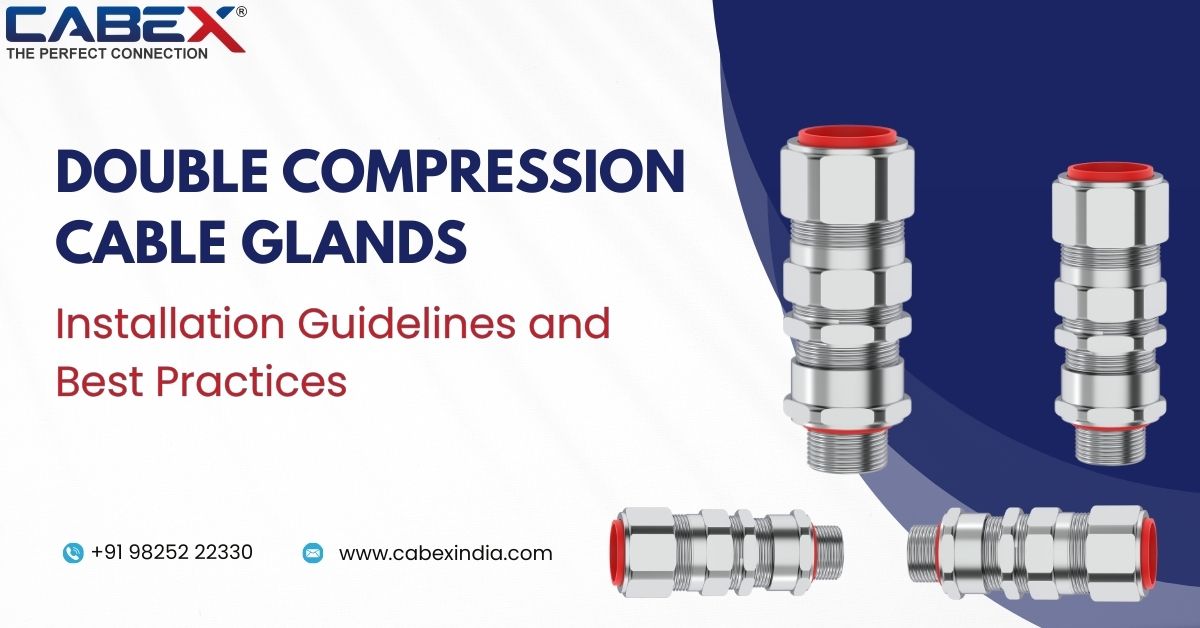Table of Contents
- Introduction
- What Are Double Compression Cable Glands?
- Why Double Compression Cable Glands Matter in Industrial Applications
- Key Industry Applications & Compliance Requirements
- Step-by-Step Installation Guide
- Best Practices for Long-Term Safety & Performance
- Material Selection: Brass, Stainless Steel, or Aluminum?
- Common Mistakes to Avoid During Installation
- Comparison: Single vs Double Compression Cable Glands
- Role of Compliance: ATEX, IECEx, PESO & CE Certification
- Why Choose Cabex India for Industrial Cable Solutions?
- Conclusion
- FAQs
Introduction
In heavy industries such as oil & gas, petrochemicals, power plants, and construction, the success of an electrical system depends not only on high-powered machinery but also on the reliability of the smallest fittings. One such critical component is the Double compression cable gland. Far more than a simple connector, these glands are safety-critical devices ensuring that armored cables remain sealed, secured, and compliant with global safety standards.
Cabex India, with its global accreditation (ATEX, IECEx, CE, PESO), has become a trusted name for industrial cable glands and hazardous area cable gland accessories across Europe, UK, Australia, Middle East, and Far East markets.
What Are Double Compression Cable Glands?
A double compression cable gland is a mechanical fitting that provides two levels of sealing:
- One at the inner sheath, where the gland grips tightly on the cable insulation
- One at the outer armor layer, sealing the armored protection against dust, moisture, and hazardous elements
This makes them indispensable for hazardous areas, outdoor environments, and high-demand industrial projects.
Why Double Compression Cable Glands Matter in Industrial Applications
- Enhanced Safety: By providing dual sealing, they prevent the passage of gas, vapor, and dust.
- Explosion Proofing: Explosion proof brass cable glands are critical in refineries and chemical plants.
- Mechanical Strength: Protect against pulling forces and strain on cables.
- Longevity: Brass, stainless steel, and other high-grade metals ensure decades of reliable performance.
👉 Cabex India is not just a supplier, but a global manufacturer with more than 25 years of experience in electrical safety components.
Key Industry Applications & Compliance Requirements
Major Sectors Using Double Compression Glands
- Oil & Gas platforms
- Petrochemical refineries
- Power plants and grids
- Infrastructure and railways
- Heavy manufacturing & steel plants
Compliance Requirements
Global buyers seek assurance through certifications like:
- ATEX & IECEx – Explosion-proof compliance for Zone 1 and Zone 2 areas
- PESO (India) – Compliance for petroleum industry installations
- CE Marking – European safety conformity
👉 Cabex India’s glands are accredited for all these certifications, making them globally acceptable.
Step-by-Step Installation Guide
Mistakes during installation can compromise safety. Here’s a proven method practiced by industry professionals:
- Verification: Ensure gland size matches cable diameter.
- Preparation: Strip cable sheath carefully, leaving correct armor length.
- Component Assembly: Arrange gland kit (locknut, washer, sealing ring, armor clamp, gland body).
- Tightening: Use a calibrated torque wrench to avoid over or under-tightening.
- Inspection: Conduct IP ingress tests (IP66–IP68) before energizing systems.
👉 Always use original Hazardous Area Cable Glands Accessories with your cable glands for compliance.
Best Practices for Long-Term Safety & Performance
- Choose brass for general industrial use, stainless steel for offshore, and aluminum for lightweight setups
- Always verify thread compatibility (NPT/Metric/PG)
- Use shrouds to protect glands from direct environmental exposure
- Maintain inspection cycles every 6–12 months in hazardous areas
- Document torque test values for compliance audits
Material Selection: Brass, Stainless Steel, or Aluminum?
| Material | Benefits | Applications |
| Brass (Nickel Plated) | Explosion-proof, corrosion-resistant | Oil & Gas, Petrochemicals |
| Stainless Steel | Superior corrosion resistance | Marine, offshore rigs |
| Aluminum | Lightweight, cost-efficient | General electrical setups |
Cabex India specializes in explosion-proof brass cable glands, while also offering variants for offshore and lightweight applications.
Common Mistakes to Avoid During Installation
❌ Using a mismatched gland size
❌ Over-tightening is causing seal deformation
❌ Ignoring certification compliance
❌ Reusing glands after disassembly
❌ Not applying protective accessories in harsh climates
Comparison: Single vs Double Compression Cable Glands
| Feature | Single Compression | Double Compression |
| Sealing Points | One | Two |
| IP Rating | Moderate (IP54–65) | High (IP66–68) |
| Application | Domestic | Hazardous/Industrial |
| Compliance | Basic | ATEX, IECEx, PESO |
| Price | Lower | Higher, justified by safety |
Role of Compliance: ATEX, IECEx, PESO & CE Certification
Industries operating with flammable gases and volatile compounds cannot risk uncertified fittings. Certification ensures:
- Tested against excessive pressure & thermal stability
- Guaranteed IP & explosion-proof integrity
- Globally acceptable installation audits
Cabex India’s products are among the few in India with ATEX, IECEx, CE & PESO approvals.
Why Choose Cabex India for Industrial Cable Solutions?
Since 1995, Cabex India has built credibility by delivering:
- Zero-defect manufacturing with cutting-edge R&D
- Customized solutions tailored for client projects
- Global reach – Europe, UK, Middle East, Australia
- Comprehensive portfolio: Industrial Cable Glands, Hazardous Area Accessories, earthing & lightning protection systems
👉 Partner with Cabex India for reliable industrial cable management & safety systems.
Conclusion
Double compression cable glands are the silent guardians of safe electrical installations across industries. By securing armored cables against hazards like gas leaks, dust ingress, and moisture, they ensure uninterrupted operations. Companies that compromise on cheaper, uncertified alternatives risk not just safety breaches but audit failures, legal penalties, and catastrophic accidents.
With its 30+ year legacy, zero-defect manufacturing, global accreditations, and strong export credibility, Cabex India is your most reliable partner for industrial cable termination systems.
👉 Looking for internationally certified double compression cable glands for your next project?
Contact Cabex India today and secure your systems with the industry’s most trusted name.
FAQs
Q1: Why are double compression glands safer than single compression?
Because they provide dual sealing, protecting both inner sheath and armor, making them essential for hazardous areas.
Q2: Which material should I choose for explosion-proof applications?
Nickel-plated brass is most common for explosion-proof brass cable gland use, while stainless steel fits marine/offshore.
Q3: How often should I inspect cable glands in refineries?
Every 6–12 months. Regular checks prevent corrosion-related failures.
Q4: Can double compression glands be used in outdoor construction projects?
Yes, with protective shrouds, they provide lasting IP66–IP68 weather protection.
Q5: What certifications should buyers demand for hazardous area glands?
Always verify ATEX, IECEx, CE, and PESO compliance before approval.
You May Also Like: Types of Wire: Guide to Understanding, Buy Explosion Proof Cable Glands Online





